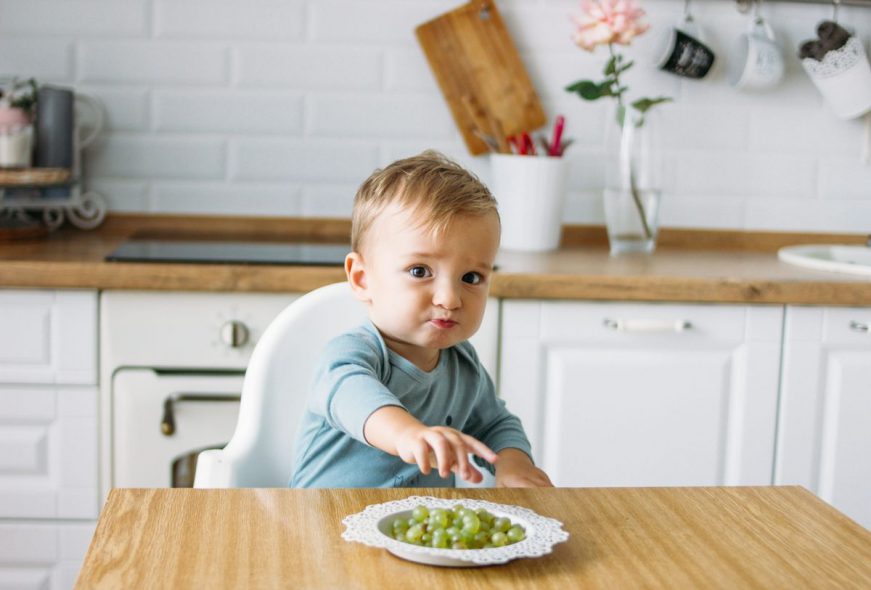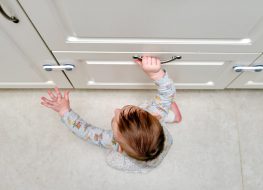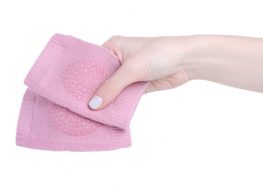
Some babies are unconcerned with cabinets. Whatever is concealed away from them isn’t as interesting as their amazing toys. You’re most likely reading this article because the previous two sentences don’t describe your baby. Children are naturally curious and frequently venture into the unknown without hesitation. It’s endearing to watch a toddler explore the world, but it might be hazardous if you look away.
Aside from cabinets, kitchens are full of other potential safety hazards for little ones. But with a few simple precautions, you can help keep your child safe. Here are seven tips to help you safeguard your beloved.
Install cabinet door locks.
Different lock designs cater to specific cabinet or drawer handles and mechanisms. You may be able to employ latches or a double door cabinet lock that connect the handles. Another option is a door lock inside the cabinet doors, which hooks in to prevent your child from opening the cabinet. The best option is a sliding cabinet door lock if you have sliding doors for your cabinets.
Safety Hazards of Cabinets
- Cabinets may contain hazardous objects such as knives or other sharp objects and toxic chemicals.
- Your kid’s fingers can get trapped between the wedges or have the cabinet door shut on them.
- Your child can get trapped inside the cabinet.
- If they decide to go in, they might hit their head on sharp edges or exposed screws inside the cabinet.
Baby-proof your low cabinets.
Many people store their cleaning materials and other toxic substances under the sink. You may also keep medicine or choking hazards in low cabinets, which can be dangerous for children. Finally, you need to relocate any food items—they are choking hazards, and some are dangerous when consumed in large amounts.
Although a cabinet door lock can help, you can never be too sure when it comes to the safety of your little one. So move anything potentially harmful to your child to areas hard to reach for them.
Install outlet covers and hide exposed cables.
When little children see an exposed cable, their initial reaction is to tug on it. However, if that wire is attached to an appliance on the countertop, it may fall on your kid’s head. To prevent this from happening, keep all wires out of reach or store appliances upright when not in use. If there are wall sockets within your child’s reach, install plastic outlet covers to prevent them from sticking anything in the socket or pulling plugged-in cables.
Reverse the position of your pot handles and utilize back burners.
Most of us have had the experience of trying to cook with a toddler underfoot. Suddenly, those pot handles sticking out from the stove become a big hazard. But there’s an easy way to make your kitchen safe for little ones: just reverse the position of your pot handles and utilize back burners. This way, the handles will point in instead of out, and they’ll be out of reach from curious toddlers. Plus, using back burners can help prevent your child from touching hot burners and make cooking with kids a little less chaotic. So next time you’re getting ready to cook, make sure your pot handles are in the right position. It might just save you from a headache (or a trip to the emergency room).
Keep anything hot or sharp away from the edge of counters or tables.
Keeping the spaces in your home safe for your child is tantamount if you’re a parent. You might have baby-proofed your electrical outlets and installed cabinet locks, but one hazard is often overlooked: sharp or hot objects near the edge of tables and countertops.
It’s easy to think that young children are unlikely to encounter these dangers, but all it takes is one curious toddler to pull a hot pan off the stove or grab a knife from the counter. So to make your home safe, make sure you keep anything hot or sharp away from the edge of your table or countertops. It will help prevent accidents and give you some assurance.

Put your kid in a high chair.
The simplest solution to kitchen hazards. You know that young children get into everything, and it can seem like an endless game of whack-a-mole to keep them safe. But one way to make your life a little easier (and your toddler a lot safer) is to put them in a high chair in the kitchen.
That way, they can be right there with you while you’re cooking, and you don’t have to worry about them getting into dangerous situations. Plus, it’s a good way to spend time with your child while you’re cooking meals. Your toddler will love being part of the action, and you’ll love having one less thing to worry about.
Maintain your smoke detector.
You might be extra vigilant about fire safety if you’ve got little ones running around. But even if your home is toddler-proof, you’re not off the hook. You still have to be sure your smoke detectors are functioning perfectly. After all, it’s not just young kids who are at risk in a fire— everyone in the family is vulnerable.
Fortunately, it’s easy to keep your smoke detectors in good shape. Just remember to test them monthly and give them a quick vacuum now and then to get rid of any dust buildup. Always make sure to replace the batteries every year. Then, with a little bit of care, you can rest assured that your smoke detectors will be there to give you an early warning if a fire ever breaks out.
Conclusion
Kitchen safety should be a top priority for all parents, and it’s especially important to childproof this room. We hope these tips will help you make your kitchen safe for your little ones. Check out our other articles for more information on keeping your child safe in the kitchen or around the house. You can also find an assortment of baby safety items in our store that will help keep your baby safe and sound.



